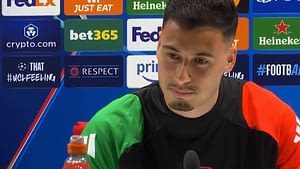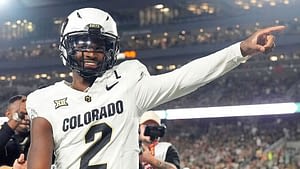Shedeur Sanders’ Surprising Slide in the NFL Draft: What It Means for the Cleveland Browns
In a move that left many NFL fans and analysts scratching their heads, the Cleveland Browns made a bold decision during the 2025 NFL Draft. On Saturday, they traded their 166th and 192nd picks to the Seattle Seahawks to select Colorado quarterback Shedeur Sanders with the 144th overall choice. This marked the end of a surprising slide for Sanders, who was once considered a top quarterback prospect in this draft class.
Sanders’ journey from a potential first-round pick to a Day 3 selection was unexpected, to say the least. The Browns had shown significant interest in Sanders throughout the predraft process. A large contingent of Browns coaches, executives, and even the ownership group traveled to Boulder, Colorado, to have dinner with Sanders and his former teammate Travis Hunter the night before their pro day workout. Despite this interest, Sanders found himself landing in Cleveland much later than many had anticipated.
The timing of Sanders’ arrival in Cleveland is intriguing, as it coincides with a critical juncture for the Browns’ franchise. Just last month, owner Jimmy Haslam publicly acknowledged that the team’s 2022 trade for quarterback Deshaun Watson was a “big swing-and-miss.” This trade had cost Cleveland three first-round picks and a fully-guaranteed $230 million contract. Watson’s performance on the field has been disappointing, and he is expected to miss a significant portion of the 2025 season due to a right Achilles injury that he re-tore in the offseason.
Interestingly, Sanders is not the only quarterback the Browns selected in the 2025 draft. They had already picked Oregon’s Dillon Gabriel in the third round. Sanders now joins a revamped quarterback room that includes veterans Joe Flacco and Kenny Pickett, both of whom were added this offseason.
Why Did the Browns Select Sanders After Drafting Gabriel?
The decision to pick Gabriel over Sanders in the third round was already surprising, but the Browns’ move to trade up for Sanders two rounds later was even more unexpected. According to general manager Andrew Berry, it was all about maximizing value at the quarterback position. Berry admitted that he didn’t initially plan to draft two quarterbacks but was open to the idea as the draft unfolded. As Day 3 began, Berry and his staff discussed the possibility of targeting Sanders if he continued to fall in the draft. Ultimately, Berry decided that the value of selecting Sanders was too great to pass up.
- Berry stated, “Once it got to a point where it felt like it was a pretty steep discount, we just felt like, especially relative to the alternative ways that we could use this selection, this made the most sense.” — Oyefusi
What Caused Sanders’ Slide in the Draft?
Sanders’ slide in the draft was puzzling, especially considering his talent. While his lack of top-end talent left him without an NFL home after Day 1, the slide out of Day 2 was harder to explain. According to NFL insider Jeremy Fowler, the league seemed to have concerns about Sanders’ draft profile. There were whispers that his predraft process, particularly his interviews, did not go well. Additionally, teams are wary of distractions, and if they felt Sanders’ presence would be one, his ability at the next level wasn’t enough to offset those concerns. Furthermore, the logistical issue of a scarcity of teams in need of a passer by the third round contributed to his slide.
What Are People Around the League Saying About Sanders’ Slide?
Many evaluators graded Sanders as a Day 2 pick, and some even considered him a late first-rounder. This makes his fall to the fifth round seem a bit ridiculous. The Browns are seen as a good fit for Sanders, as they lack an unquestioned starter. Stylistically, Sanders is a fit for head coach Kevin Stefanski’s offense, which thrives on play action. However, Sanders faces a challenge as the Browns drafted Gabriel two rounds ahead of him. This situation highlights the thin margins in the predraft process, where perceptions can vary widely by team.
What Are Sanders’ Prospects for Playing Time in 2025?
Browns coach Kevin Stefanski has made it clear that anyone added to the quarterback room will be expected to compete for starting time. Sanders enters a four-man race with experienced veteran Flacco, former first-round pick Pickett, and fellow rookie Gabriel. The Browns are rebuilding their offensive scheme with a new quartet of passers, and Stefanski is confident in their plan to give each player a fair opportunity.
Does This Officially Close the Book on the Watson Era in Cleveland?
The Browns have acknowledged that Watson’s health status makes his future uncertain. With two more years remaining on his five-year contract, the team owes him $46 million in each of the next two seasons. However, the Browns have been operating as if Watson will not be available for the 2025 season, and their recent moves suggest an attempt to move on at the quarterback position. Releasing Watson after the 2025 season with a post-June-1 designation would result in a $135 million dead cap charge, which could be split between the 2026 and 2027 seasons.
How Important Is Figuring Out the QB Situation to Stefanski and Berry’s Future?
It’s paramount. When Stefanski and Berry arrived in 2020, they inherited quarterback Baker Mayfield and developed him into a quality starter. However, the relationship with the organization soured, leading to the trade for Watson. Since then, eight different quarterbacks have started for the Browns. Despite a 3-14 finish last season, Haslam has expressed confidence in Stefanski and Berry, who were given extensions last offseason. Now, with two young quarterbacks in Sanders and Gabriel, the Browns hope to find a long-term answer at the position.
What Are the Browns Getting with Sanders on the Field?
Sanders is known for his physical and mental toughness. He can take big hits to make plays and elevate his game in critical situations. While he held onto the ball too long in 2024, he has shown the ability to get the ball out quickly and pick apart defenses with short to intermediate passes. Sanders can throw receivers open, hold safeties with his eyes, and make off-platform throws. His arm is strong enough to make every throw, and he can scramble for first downs. Stefanski has had success coaching accurate quarterbacks like Case Keenum and Kirk Cousins in the past, and both Gabriel and Sanders fit that mold.
Originally Written by: Multiple contributors





















